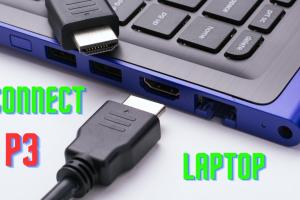How to Easily Connect Your PlayStation 3 to a Laptop: A Step-by-Step Guide

-
Quick Links:
- Introduction
- Requirements
- Methods to Connect PS3 to Laptop
- Troubleshooting Common Issues
- Case Studies & Examples
- Expert Insights
- FAQs
Introduction
Connecting your PlayStation 3 to a laptop can seem daunting, but it opens up a world of possibilities for gaming on the go. Whether you want to stream games, enjoy multiplayer sessions, or simply use your laptop screen as a display, we have you covered. In this guide, we will explore various methods to connect your PS3 to a laptop, including step-by-step instructions, the necessary equipment, and troubleshooting tips.Requirements
To successfully connect your PlayStation 3 to your laptop, you will need the following items:- PlayStation 3 Console
- Laptop with HDMI input or capable of running streaming software
- HDMI cable (for direct connection)
- USB cable (for Remote Play)
- Software for emulation (if applicable)
Methods to Connect PS3 to Laptop
Method 1: Using HDMI Cable
Connecting your PS3 to your laptop using an HDMI cable is the most straightforward method, provided your laptop supports HDMI input. Follow these steps:- Turn off both your PS3 and laptop.
- Connect one end of the HDMI cable to the PS3 and the other end to the HDMI input port on your laptop.
- Power on the laptop and then the PS3.
- On your laptop, switch to the HDMI input mode (if applicable).
- Adjust the display settings on your laptop to extend or duplicate the screen as needed.
Method 2: Using Remote Play
Remote Play allows you to connect your PS3 to a laptop wirelessly. Here’s how to do it:- Ensure your PS3 is connected to the same network as your laptop.
- Download and install the official Remote Play software on your laptop.
- Connect your PS3 controller to your laptop via USB cable.
- Launch the Remote Play software and follow the on-screen instructions to pair with your PS3.
- Enjoy gaming on your laptop display!
Method 3: Using Software Emulation
If you don’t have an HDMI input, you can use software to emulate the PS3 experience. Here’s a basic outline:- Download a PS3 emulator compatible with your laptop's operating system.
- Install the emulator and follow the setup instructions, ensuring you have the required BIOS and game files.
- Configure the emulator settings according to your laptop’s specifications.
- Launch games directly from the emulator.
Troubleshooting Common Issues
Connecting your PS3 to a laptop may come with its own set of challenges. Here are some common issues and their solutions:- No Signal: Ensure that the HDMI cable is securely connected and that the laptop is set to the correct input mode.
- Lagging or Poor Quality: Check your laptop’s performance specs and close unnecessary applications to free up resources.
- Controller Not Connecting: Ensure the USB cable is functioning and try different USB ports.
Case Studies & Examples
Many gamers have successfully transitioned to using laptops for their PS3 gaming needs. For instance, a gamer named Tom from California reported how connecting his PS3 to his laptop allowed him to game in different rooms without being tethered to a TV. By using Remote Play, he could enjoy his favorite titles while multitasking on his laptop.Expert Insights
According to gaming expert Dr. Jennifer Lee, “Connecting your gaming console to a laptop not only provides flexibility but also enhances the gaming experience by allowing for portability.” She emphasizes that understanding the capabilities of your laptop is crucial in determining the best connection method.FAQs
1. Can I connect my PS3 to a laptop without HDMI?
Yes, you can use Remote Play or software emulation as alternatives.
2. What if my laptop doesn't have an HDMI input?
Consider using Remote Play or an emulator to play games on your laptop.
3. Is it possible to use the laptop screen as a display for my PS3?
Yes, if your laptop has an HDMI input or by using Remote Play.
4. How do I set up Remote Play?
Download the software, connect your PS3 and laptop to the same network, and follow the pairing instructions.
5. Can I play my PS3 games on a laptop?
Yes, either through Remote Play or using a PS3 emulator.
6. Will using Remote Play affect game performance?
It may introduce some lag depending on your network speed and stability.
7. Do I need special software to connect my PS3 to my laptop?
Yes, for Remote Play, you will need the official software and potentially additional emulation software.
8. Can I connect multiple controllers to my laptop for multiplayer gaming?
Yes, as long as your laptop supports multiple Bluetooth connections or has enough USB ports.
9. How do I troubleshoot connection issues?
Check your cables, ensure the correct input is selected, and verify network connections.
10. Are there any risks associated with using emulators?
Using emulators can sometimes breach copyright laws, so ensure you own the original game files.
Random Reads
- How to solve a series circuit
- How to soundproof wall ceiling
- The complete guide to removing hair in your bathroom
- Customize windows 7 taskbar icons
- Customize windows desktop icons
- How to open ppt file pc mac
- How to open rar files
- Simple techniques create clouds photoshop
- Simple steps turn on comcast cable box
- How to catch articuno fire red leaf green